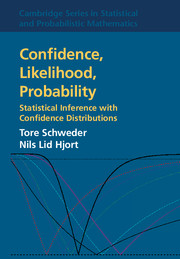Book contents
- Frontmatter
- Dedication
- Contents
- Preface
- 1 Confidence, likelihood, probability: An invitation
- 2 Inference in parametric models
- 3 Confidence distributions
- 4 Further developments for confidence distribution
- 5 Invariance, sufficiency and optimality for confidence distributions
- 6 The fiducial argument
- 7 Improved approximations for confidence distributions
- 8 Exponential families and generalised linear models
- 9 Confidence distributions in higher dimensions
- 10 Likelihoods and confidence likelihoods
- 11 Confidence in non- and semiparametric models
- 12 Predictions and confidence
- 13 Meta-analysis and combination of information
- 14 Applications
- 15 Finale: Summary, and a look into the future
- Overview of examples and data
- Appendix: Large-sample theory with applications
- References
- Name index
- Subject index
7 - Improved approximations for confidence distributions
Published online by Cambridge University Press: 05 March 2016
- Frontmatter
- Dedication
- Contents
- Preface
- 1 Confidence, likelihood, probability: An invitation
- 2 Inference in parametric models
- 3 Confidence distributions
- 4 Further developments for confidence distribution
- 5 Invariance, sufficiency and optimality for confidence distributions
- 6 The fiducial argument
- 7 Improved approximations for confidence distributions
- 8 Exponential families and generalised linear models
- 9 Confidence distributions in higher dimensions
- 10 Likelihoods and confidence likelihoods
- 11 Confidence in non- and semiparametric models
- 12 Predictions and confidence
- 13 Meta-analysis and combination of information
- 14 Applications
- 15 Finale: Summary, and a look into the future
- Overview of examples and data
- Appendix: Large-sample theory with applications
- References
- Name index
- Subject index
Summary
Previous chapters have developed concepts and methodology pertaining to confidence distributions and related inference procedures. Some of these methods take the form of generally applicable recipes, via log-likelihood profiles, deviances and first-order large-sample approximations to the distribution of estimators of the focus estimands in question. Sometimes these recipes are too coarse and are in need of modification and perfection, however, which is the topic of the present chapter. We discuss methods based on mean and bias corrected deviance curves, t-bootstrapping, a certain acceleration and bias correction method, approximations via expansions, prepivoting and modified likelihood profiles. The extent to which these methods lead to improvements is also briefly illustrated and discussed.
Introduction
Uniformly most powerful exact inference is in the presence of nuisance parameters available only in regular exponential models for continuous data and other models with Neyman structure, as discussed and exemplified in Chapter 5. Exact confidence distributions exist in a wider class of models, but need not be canonical. The estimate of location based on the Wilcoxon statistic, for example, has an exact known distribution in the location model where only symmetry is assumed; see Section 11.4. In more complex models, the statistic on which to base the confidence distribution might be chosen on various grounds: the structure of the likelihood function, perceived robustness, asymptotic properties, computational feasibility, perspective and tradition of the study. In the given model, with finite data, it might be difficult to obtain an exact confidence distribution based on the chosen statistic. As we shall see there are various techniques available for obtaining approximate confidence distributions and confidence likelihoods, however, improving on the first-order ones worked with in Chapters 3–4.
Bootstrapping, simulation and asymptotics are useful tools in calculating approximate confidence distributions and in characterising their power properties. When an estimator, often the maximum likelihood estimator of the interest parameter, is used as the statistic on which the confidence distribution is based, bootstrapping provides an estimate of the sampling distribution of the statistic. This empirical sampling distribution can be turned into an approximate confidence distribution in several ways, which we address in the text that follows.
- Type
- Chapter
- Information
- Confidence, Likelihood, ProbabilityStatistical Inference with Confidence Distributions, pp. 204 - 232Publisher: Cambridge University PressPrint publication year: 2016



